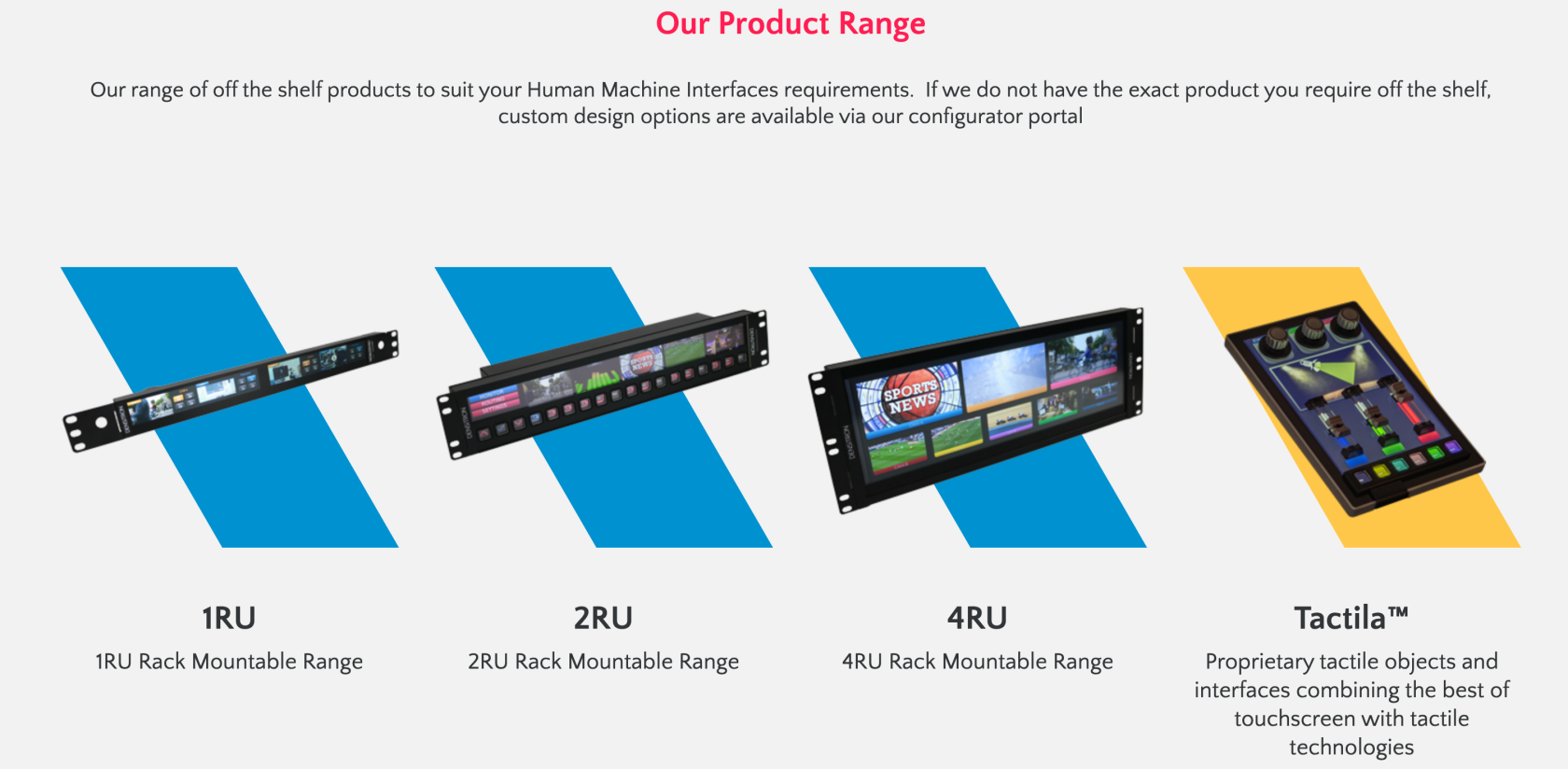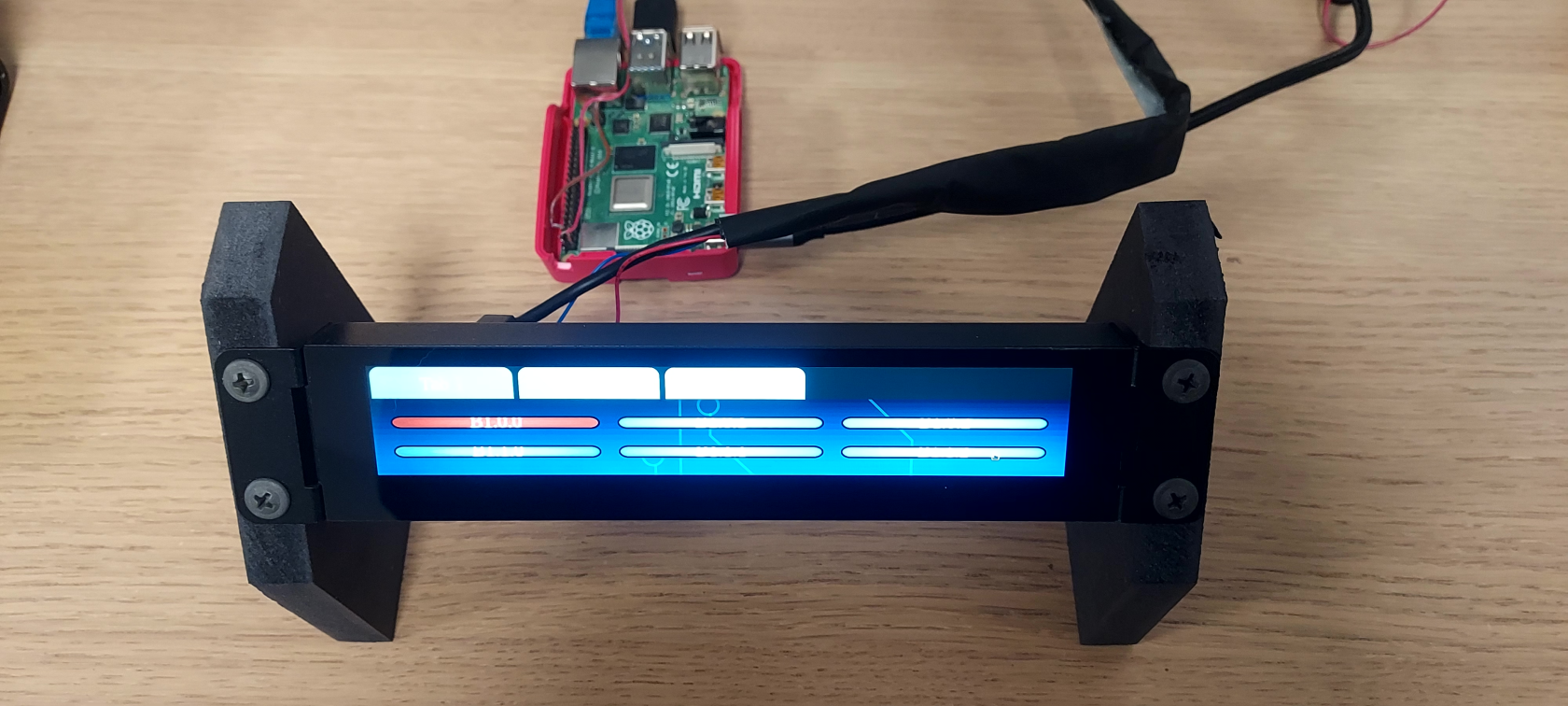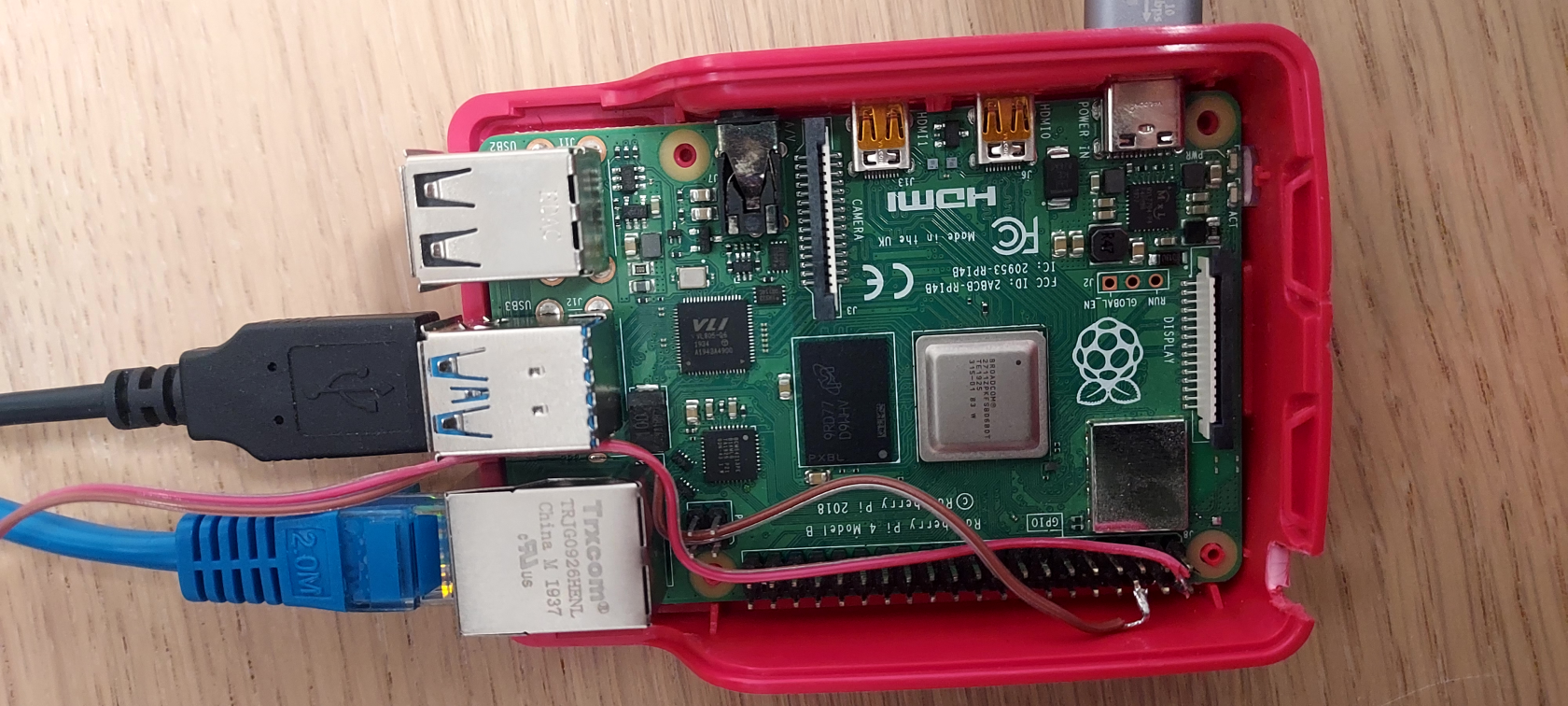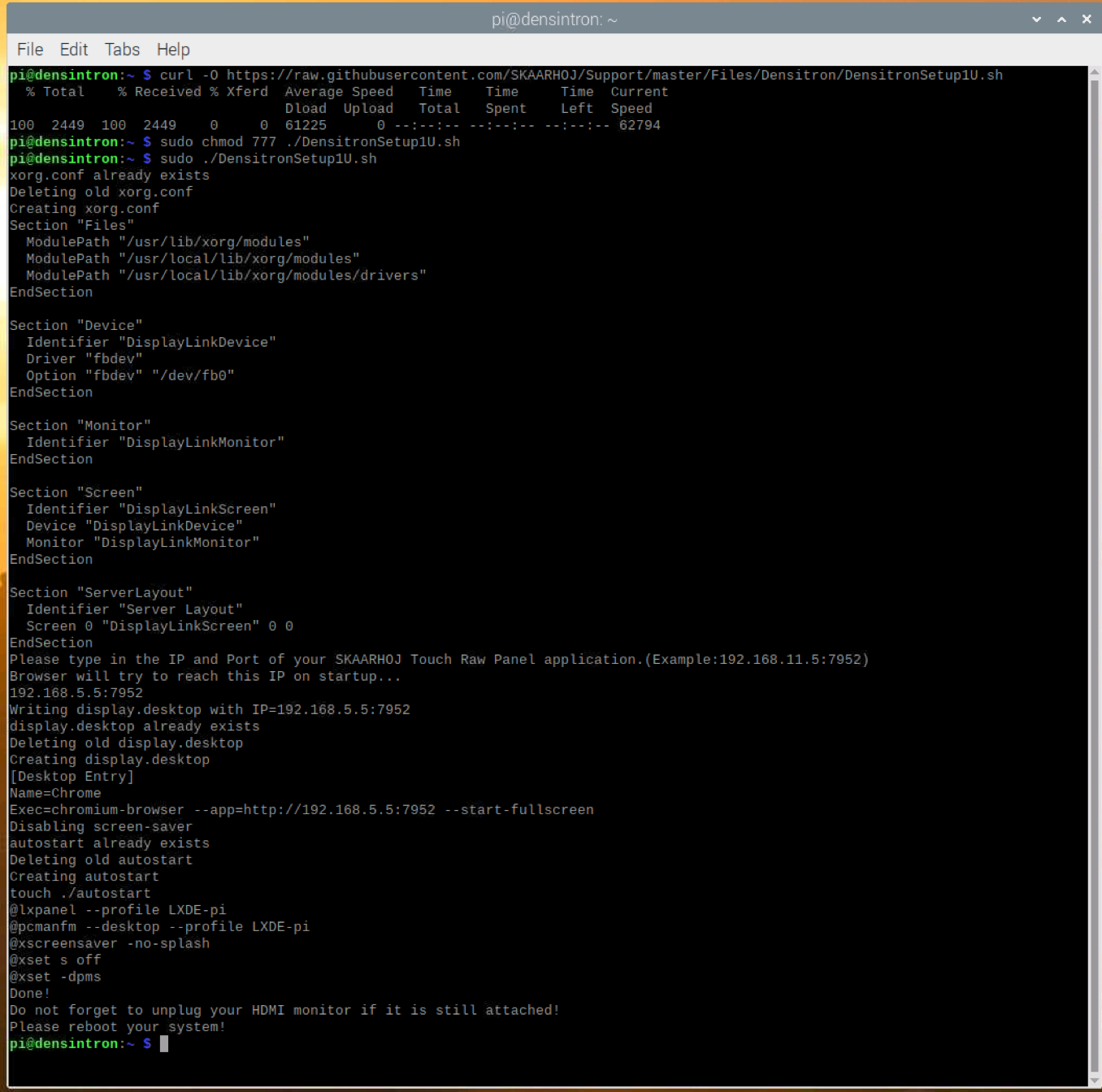Using Densitron UReady 1U and UReady 2U Displays for with Raw Panel
The SKAARHOJ xpanel-touch package allows users to create browser-accessible software UIs, appearing on the local network as Raw Panel devices.
Densitron presents compelling touch screen options for use with xpanel-touch. Their rack-mountable designs are notable. Additionally, certain screens come equipped with an internal computer, enabling direct web browser operation on the screen without requiring an external driving computer.
Options include:
- A 2RU or 4RU unit with an integrated computer.
- Build a compact "rack" style touch panel using a 1RU USB display and a Raspberry Pi driving it.
Choose a 2RU unit with an integrated computer.
This guide will assist in quickly setting up such configurations.
UReady 2U (with built-in x86) setup
Luckily,The UReady 2U displays, and likely the units4U shipversions as well, are available with HDMI like a regular monitor or with a built-in computer. This setup guide focuses on the latter.
Initial Setup:
-
Out-of-the-Box Functionality:
- The units come pre-installed with the Lubuntu
distributiondistribution,installed andwhich shouldalreadywork"work"immediatelyoutupon setup. This simplifies the process, requiring only the setup ofthe box. That minimizes the effort needed to get it up and running, the only thing we need to do is to set upan autostartflowsequence to open the browser infullfull-screen mode.
Our - The units come pre-installed with the Lubuntu
-
Preparing for Setup:
- Since our unit
camedidwithnot have an SSH servernotinstalled,so weyou will need a keyboardandand,preferablypreferably,mouseainmouse. - The
to set it up. Thedefault username and password are "densitron/densitron."
order - Since our unit
-
PluginConnect your keyboard and mouse to theunit and power it on.unit.OncePower on the unit.
Physical Setup:
-
Access Terminal:
- After the device
hasboots,booted,locatefindthe terminal iconinon the taskbar andlaunchopen it.
- After the device
WeneedCreate
toAutostart Entry:-
To create a new autostart entry,
to do sotype the following command:in the terminal:
-
sudo nano /etc/xdg/autostart/display.desktopEnterIf prompted, enter the passwordpassword. ifThis asked.action Wewill should end-up withopen an empty file open.for editing.
Lubuntu hascomes with the Firefox Browser installedpre-installed, bywhich default,you'll souse for this issetup.
You wewill are goingneed to use.edit Thethe content of the file to suit your needs. The content should lookresemble likethe below,following excepttemplate, ofbut ipyou'll need to replace it with the IP address and port of your XTOUCHxpanel-touch server :server:
[Desktop Entry]
Name=Firefox
Exec=firefox --kiosk http://192.168.11.5:7952Save the changes and exit!exit. BasicallyThat's thisall there is to it! Next timeWhen the panel restarts therestarts, Firefox browser will be openedopen in "fullfull-screen screen"mode onat the address you have enteredspecified in the config.
If at some point you need to change the ip,IP justaddress later, simply edit the file again.
sudo nano /etc/xdg/autostart/display.desktopIfTo prevent the browser from automatically starting up, you wantcan tofollow stopthese autostarting the browser:steps:
sudo rm /etc/xdg/autostart/display.desktop
UReady 1U + Raspberry Pi 4 setup
Prerequisites
- Raspberry Pi 4
- 5V/3A PSU with USB Type C cable
- DM-066GN-OPUR01 UReady 1U Single Monitor
- microSD card for the operating system
- USB keyboard/mouse (only needed during initial setup)
- Monitor (only needed during initial setup)
- USB FlashDrive (optional, only needed during initial setup)
Extra Power for Densitron Screen
It has been observed that powering theThe Densitron UReady 1U screen solelyrequires viaadditional USB5V canpower. beThere unstable.are Totwo resolverecommended this, we recommend the following modificationmethods to provide additionalthis powerpower:
-
DensitronUsing
screen:a MicroUSB CablePrepareConnect an additional microUSB cable from one of the twowires,"USBapproximatelyOut" ports on thesamescreenlengthtoas the microanother USBcableportyou plan to use betweenon the Raspberry Piandor to an external power supply. This is probably theDensitroneasiest.
screen. SoldertheseUsing
wiresato5V Power Plug:- Alternatively, you can use the 5V
andPowerGND pins on the Raspberry Pi. Solder the other ends of these wires to the respective 5V input port on the Densitron screen,Plug, which islocatedcompatibleonwiththeabackMolexof43025-0200theandscreen.43030 series crimp terminals.
- Alternatively, you can use the 5V
Operating System
- We recommend using the Raspbian OS (Buster) version dated 2020-08-24. It can be downloaded here.
- We suggest using the Raspberry Pi Imager for flashing the OS. It's available for various operating systems and can be downloaded here.
- If you're unsure about the process at this stage, helpful guidance can be found in this article.
Setting Up Your Touch Panel:
-
Initial Setup:
- Insert the pre-flashed SD card into the Raspberry Pi (RPI).
- Connect a HDMI-compatible monitor and the USB keyboard and mouse.
- Connect the Densitron screen to the RPI using a USB-A to microUSB cable (into either USB 2.0 or USB 3.0 port). Note: The Densitron screen won't display anything at this stage.
- Power on the RPI.
-
Complete Raspbian OS Installation:
- Follow the onscreen instructions to complete the installation. This includes setting up the user, time zone, WiFi network, etc.
-
Enable Remote Access:
- To facilitate future adjustments without needing a keyboard and mouse, enable SSH and VNC servers on the RPI.
- Click the raspberry icon in the upper left corner of the screen.
- Navigate to Preferences -> Raspberry Pi Configuration.
- In the 'Interfaces' tab, enable SSH and/or VNC.
- Click 'OK' and reboot the RPI.
After rebooting, you should be able to remotely access the RPI via SSH or VNC.
Post-Setup Process
Now, our next steps are to activate the Densitron screen and configure the browser to automatically open at the required URL address. To simplify this process, we have created a small shell script that will automatically make the necessary modifications for you.
Easy Setup Method
- Open the Terminal application on your Raspberry Pi.
- Run the following command to download the script. (If your Raspberry Pi doesn't have internet access, download the file on another machine with internet access and transfer it to your Raspberry Pi using a USB flash drive. Then, continue from step 3.)
curl -O https://raw.githubusercontent.com/SKAARHOJ/Support/master/Files/Densitron/DensitronSetup1U.sh3. Next we need to give permissions to execute the file we have just downloaded. Execute following command:
sudo chmod 777 ./DensitronSetup1U.sh4. Now we are ready to execute the script. Execute following command:
sudo ./DensitronSetup1U.shWhen prompted, enter the IP address and port of your xpanel-touch web server (the Blue Pill device where it's installed) and then press ENTER.
5. That is it, you can now power down your RPI, disconnect keyboard,mouse and HDMI screen. Next time you power it on the browser should open in full screen mode on the Densitron screen.
Advanced Setup Method
For advanced users interested in creating a custom setup, such as combining two Densitron screens or pairing a Densitron screen with an HDMI screen, detailed guidance is beyond the scope of this introductory tutorial. However, we will provide some basic hints to get you started:
- Edit or create /etc/X11/xorg.conf - in order to "describe" your multi monitor setup.
- Edit or create /etc/xdg/autostart/display.desktop for browser auto startup "tuning".
- Edit /etc/xdg/lxsession/LXDE-pi/autostart. It is crucial to add the following parameters:
@xset s off
@xset -dpmsIf you don't apply the recommended modifications, you may encounter USB dropouts, where the device disconnects and then reconnects during screen saver activation or wake-up. This issue can result in a 'green' and unresponsive screen. The Light Display Manager doesn't automatically detect this problem. Therefore, you'll need to either manually restart the Light Display Manager or create a udev rule to restart the service automatically when this condition occurs.
sudo service lightdm restart






